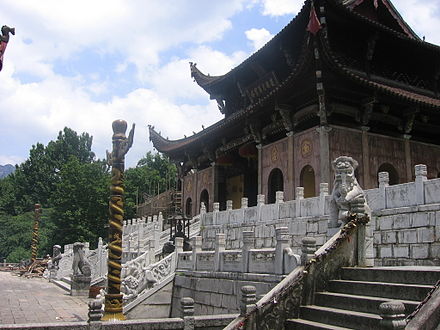Hall of Kshitigarbha
| Hall of Kshitigarbha | |||||||
|---|---|---|---|---|---|---|---|
 The Hall of Kshitigarbha at Roushen Temple, in Mount Jiuhua, Anhui, China. | |||||||
| Traditional Chinese | 地藏殿 | ||||||
| Simplified Chinese | 地藏殿 | ||||||
| Literal meaning | Hall of Kshitigarbha | ||||||
| |||||||
The Hall of Kṣitigarbha or Kṣitigarbha Hall (Chinese: 地藏殿; pinyin: Dìzàngdiàn) is one of the most important annexed halls in Chinese Buddhist temples. It is named after its primary function of enshrining the bodhisattva Kṣitigarbha and sometimes doubles as the temple mausoleum.[1]
Origin
As his name occurs in Chinese texts such as the Kṣitigarbha Bodhisattva Pūrvapraṇidhāna Sūtra (《地藏菩薩本願經》), the Chinese name of Kṣitigarbha is "Dìzàng" (地藏; lit. 'earth storehouse').[1]
The Daśacakra Kṣitigarbha Sūtra (《地藏十輪經》) elaborates:
- "Kṣitigarbha is patient and immovable like the great earth; his meditation is deep and profound like a secret storehouse."
- (「安忍不動如大地,靜慮深密如秘藏。」)
Due to Shakyamuni Buddha's exhortations, Kṣitigarbha has to cultivate all the living creatures in adherence to the Dharma and eliminate all suffering in the period spanning from Shakyamuni's Parinirvana to Maitreya's final birth. Kṣitigarbha has made the vow:
- "Until the hells are empty (of suffering beings), I will not become a Buddha."
- (「地獄不空,誓不成佛。」)
- "Once all sentient beings are saved, I will attain Buddhahood."
- (「眾生度盡,方證菩提。」)
- "If I do not descend into hell, who will?"
- (「我不入地獄,誰入地獄?」)
It is through this gesture of selflessness that he became recognized as "foremost in compassion and vows" and has been worshiped by people since ancient times.[2][3]
Enshrined image
In Chinese Buddhism, Kṣitigarbha's image is usually in the form of a Buddhist monk; complete with a robe, shaved head or in a vishnu lou cap.[1] He sits in the lotus posture and wields a khakkhara in his left hand, symbolizing the unification of compassion for all living creations whilst holding strictly to the moral precepts.[1] In his right hand is a ruyi, signifying the fulfillment of the wishes of all living creatures.[1]
Some images depict him standing in a triad that includes a father-son duo: Daoming (道明), a bhikshu who stands to his left, and Mingong (憫公), a wealthy elderly man on his right.[1]
In some larger Buddhist temples, statues of the ten King Yamas flank images of Kṣitigarbha.[1]
References
- ^ a b c d e f g Zi Yan (2012-08-01). Famous Temples in China. Beijing: Time Publishing and Media Co., Ltd. pp. 39–40. ISBN 978-7-5461-3146-7.
- ^ Wei Ran (2012-06-01). Buddhist Buildings. Beijing: China Architecture & Building Press. ISBN 9787112142880.
- ^ Han Xin (2006-04-01). Well-Known Temples of China. Shanghai: The Eastern Publishing Co. Ltd. ISBN 7506024772.
Further reading
- Wang Guixiang (2016-06-17). 《中国汉传佛教建筑史——佛寺的建造、分布与寺院格局、建筑类型及其变迁》 [The History of Chinese Buddhist Temples] (in Chinese). Beijing: Tsinghua University Press. ISBN 9787302427056.
- Zhang Yuhuan (2014-06-01). 《图解中国佛教建筑、寺院系列》 (in Chinese). Beijing: Contemporary China Publishing House. ISBN 9787515401188.
External links